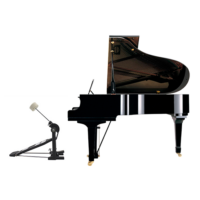A recorded interpretation might include one or many musicians, as well as one or several technicians or producers. This text focuses on a studio-recorded interpretation of a musical score for a single musician and a recording engineer.
A musician might perform an interpretation in the studio as if it were in front of an audience, but this is rarely the case. During a recording session, there is no audience, and the musician makes multiple performances of the piece, often including retakes of minor sections.
Combining these many retakes into a final recording is typically done by the recording engineer. The recording engineer also decides on the position of the microphones, the overall soundscape, and may alter performed rhythms or notes using digital tools. Despite these manipulations, the recording engineer is not seen as a significant part of the work. The ideal for most recording engineers of classical studio productions is to be invisible; the recording should appear “natural” and emulate the illusion that the listener is positioned in the sweet spot of a concert hall, listening to a live performance.
As a consequence, studio recordings are usually presented and perceived as the musician’s interpretation, with the recording engineer viewed as a technical necessity with no artistic involvement.
However, this could be different; a major potential within recorded interpretations is omitted. For example, in a recording, the audience could be placed in the position of the musician or move around different positions. It could adapt unreal speeds, colors, or dynamics, and through layering, release impossible freedom or clarity between simultaneous elements. Instead, studio recordings present themselves as if they were documentaries.
Nevertheless, it’s strange that we don’t have a tradition of distinguishing between live and recorded interpretations, considering that recordings demand a completely different mindset from live performances. Consequently, we often base our discussions of interpretation on recordings, as is also the case in some texts on this site, treating them as comparable to live performances and overlooking the distinction between digitally manipulated recordings and the reality of on-stage performances.
An example of an extremely manipulated recording is Henrik Knarborg’s interpretation of Simon Steen-Andersen’s “Splitpoint for Snaredrum, Sandpaper, and S.” In this recording, the sound is manipulated with extreme compression to make it very close, and the video is edited to underline the musical structure of the piece in a way that could never be experienced in a concert hall.
Also the following example from the beginning of Xenakis’ Psappha demonstrates the use of manipulated recorded drums to create an auditory experience different from a live performance. This production is a collaboration between Henrik Knarborg and producer Merlyn Luke Perez-Silva.
Henrik Knarborg: The beginning of Xenakis Psappha in a studie recording:
Henrik Knarborg: The beginning of Xenakis Psappha in a live performance
